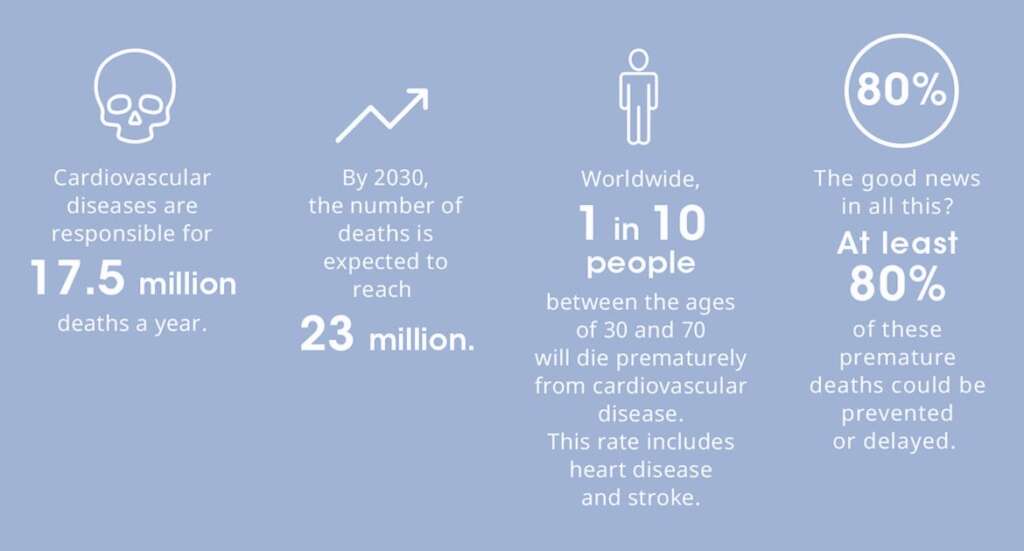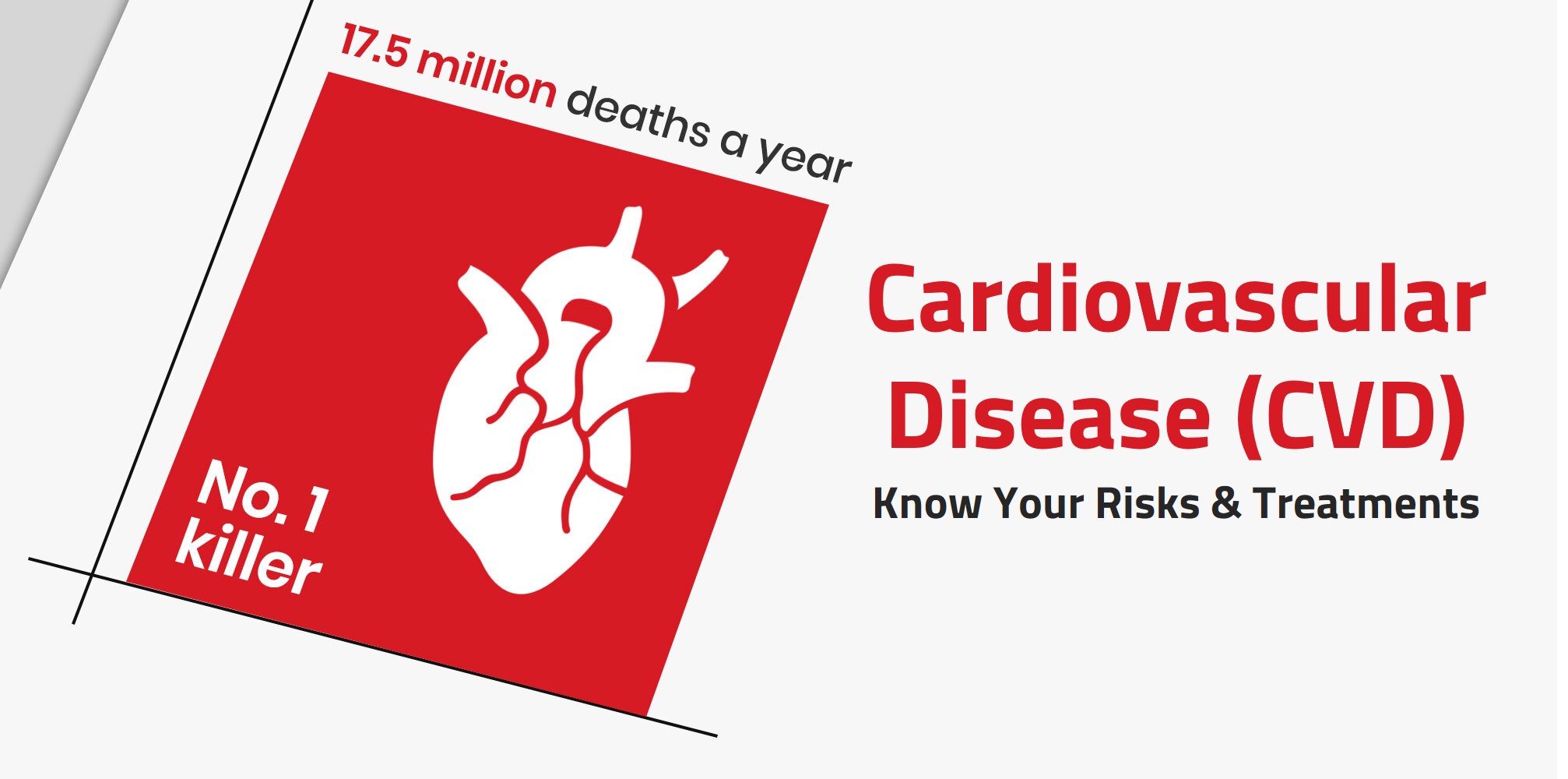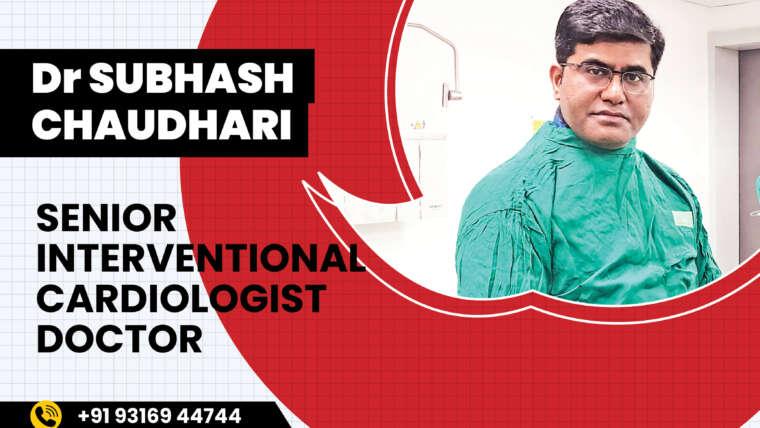Cardiovascular Disease (CVD) – Know Your Risks & Treatments
What is Cardiovascular Disease (CVD)?
Cardiovascular disease (CVD) is a general term for conditions affecting the heart or blood vessels.
It’s usually associated with a build-up of fatty deposits inside the arteries (atherosclerosis) and an increased risk of blood clots.
CVD is now the most common cause of death worldwide. The WHO estimate that by 2030, 23.6 million people will die from CVD conditions annually — mostly due to stroke and heart disease. [Source: WHO]

However, there are many ways to reduce the risk of developing these cardiovascular diseases and many treatment options are available if they occur. Let’s take a look into types of CVD, symptoms & causes and treatment or prevention options.
Types of Cardiovascular Disease (CVD)
There are many different types of CVD. Four of the main types are described below.
#1 CORONARY HEART DISEASE
This occurs when oxygen rich blood to the heart muscle is reduced or blocked.
Angina – chest pain caused by restricted blood flow to the heart.
Arrhythmia – irregular heartbeat.
Congenital heart disease – in which a problem with heart function or structure is present from birth.
Heart failure – where heart is unable to pump the blood around the body properly.
Heart attack – where the blood flow to the heart is suddenly blocked.
#2 STROKES & TIA
A stroke is where the blood supply to part of the brain is suddenly cut off, which can cause brain damage and even death.
TIA – transient ischaemic attack, is similar, but the blood flow to the brain is only temporarily disrupted.
Few symptoms to identify stroke or TIA: Face drooping on one side, arm weakness or numb, slurred or garbled speech.
#3 PERIPHERAL ARTERIAL DISEASE
Peripheral arterial disease occurs when there’s a blockage in the arteries to the limbs, usually the legs. This condition can cause:
- dull or cramping leg pain
- hair loss on legs and feet
- numbness in legs
SEE ALSO: Treatment for Peripheral Arterial Disease – Peripheral Angiography and Angioplasty
#4 AORTIC DISEASE
Aortic diseases are a group of conditions affecting the aorta.
Aortic aneurysm – where the aorta becomes weakened and bulges outwards and is one the most common aortic disease.
Aortic stenosis – a narrowing of the heart valve that can cause blockage to blood flow leaving the heart.
SYMPTOMS OF CVD
Symptoms will vary depending on the specific condition. Typical symptoms of an underlying cardiovascular issue include:
- Pain or pressure in the chest
- Discomfort in arms, elbows, jaws or back
- Shortness of breath
- Nausea or fatigue
- Dizziness
- Sweating
CAUSES OF CVD

The exact cause of CVD isn’t clear, but there are lots of things that can increase your risk of getting it. These are called “risk factors”. The main risk factors for CVD are outlined below.
- high blood pressure or hypertension
- atherosclerosis or blockages in the arteries
- radiation therapy
- smoking
- poor sleep hygiene
- high blood cholesterol or hyperlipidemia
- diabetes
- high carbohydrate diet
- physical inactivity
- obesity
- sleep apnea
- excessive alcohol consumption
- stress
- air pollution exposure
TREATMENT OF CARDIOVASCULAR DISEASE (CVD)
The treatment options for a person will depend on their specific type of CVD. However, some of the options are:
Medication – to reduce cholesterol, improve blood flow and regulate heart rhythm.
Cardiac surgery – coronary artery bypass grafting, angioplasty with stenting, valve surgery or replacement.
Cardiac rehabilitation – including exercise prescriptions and lifestyle counselling.
SEE ALSO: OTHER TREATMENT OPTIONS FOR HEART RELATED DISEASES
PREVENTING CVD
The good news is at least 80% of these deaths from CVD could be prevented or delayed. A healthy lifestyle can lower your risk of CVD. If you already have CVD, staying as healthy as possible can reduce the chances of it getting worse.
- Stop smoking
- Have a healthy and balanced diet
- Regular exercise & avoiding a sedentary lifestyle
- Maintain a healthy weight
- Cut down on alcohol
- Reducing salt, sugar, and saturated fat intake
Although these conditions remain prevalent in global mortality rates, people can start taking steps to prevent them. Everyone, even those with no symptoms, should receive regular screenings for CVD, starting from the age of 20 years.




